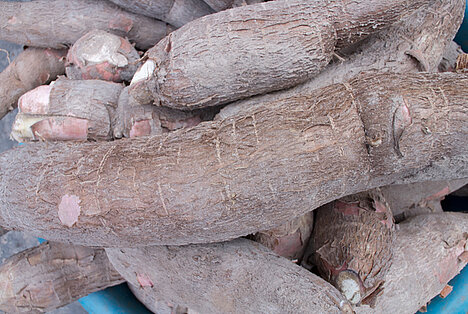Tapioca starch

What is tapioca starch?
Tapioca starch is a white, tasteless powder made from the dried and ground roots of the cassava plant. The cassava plant is a tropical plant native to South America, where it is also known as cassava, cassava or yuca. The roots of the plant contain a lot of starch, which is an important source of carbohydrates for many people.
To obtain tapioca starch, the roots are peeled, washed, crushed and pressed. This separates the starchy liquid from the solid components. The liquid is then filtered, thickened and dried until a fine powder is obtained. This powder can then be further processed into various forms such as pearls, flakes or flour.
Why is tapioca starch used in dog food?
Tapioca starch has several benefits for dog nutrition that make it a popular ingredient in many types of food. Here are some of them:
- Tapioca starch is gluten-free and hypoallergenic. This means that it does not trigger allergic reactions or intolerances in dogs that are sensitive to gluten or other grains.
- Tapioca starch is a high-quality carbohydrate source that provides quick energy and keeps blood sugar levels stable. It has a high glycemic index of 85, which means that it is digested quickly and causes blood sugar to rise rapidly. This can be beneficial for dogs that need a lot of exercise or suffer from diabetes.
- Tapioca starch has good digestibility and a high water-binding capacity. This means that it can absorb a lot of water and swell, which leads to a satiating effect and promotes intestinal health. It can also serve as a natural binding agent that holds the feed together and gives it a pleasant consistency.
- Tapioca starch has no taste of its own and therefore does not affect the taste of the food. This can be an advantage for picky dogs that would otherwise turn away from certain types of food.
What are the disadvantages of tapioca starch for dogs?
Tapioca starch is not only good for dogs, but it also has some disadvantages that you should be aware of. Here are some of them:
- Tapioca starch has low nutritional value and contains hardly any vitamins or minerals. This means that it only serves as a source of energy and does not contribute to meeting your dog's nutritional needs. You should therefore make sure that your dog's food contains enough other ingredients to provide him with all the important nutrients.
- Tapioca starch can cause digestive problems if it is fed in excessive quantities or if your dog is not used to it. Too much tapioca starch can lead to flatulence, diarrhea or constipation, as it binds a lot of water and strains the intestines. You should therefore adjust the amount you feed your dog and slowly get him used to the new food.
- Tapioca starch is relatively expensive compared to other carbohydrate sources. This is because it comes from an exotic plant that requires a lot of cultivation and processing. You should therefore check the price-performance ratio of the food and not just look at the list of ingredients.
How can you incorporate tapioca starch into your dog's food?
If you want to include tapioca starch in your dog's food, you have various options. For example, you can:
- Buy ready-made dog food that contains tapioca starch. There are many types of food that use tapioca starch as an ingredient, especially in the hypoallergenic or grain-free category. However, you should always pay attention to the quality and composition of the food and not just the advertising promises.
- Prepare your own dog food that contains tapioca starch. You can buy tapioca starch in the form of pearls, flakes or flour and mix it with other ingredients such as meat, vegetables or fruit. However, you should make sure that you use the right amount of tapioca starch and that you balance the food.
- Use tapioca starch as a treat or snack for your dog. You can also use tapioca starch as a reward or snack for your dog, for example in the form of cookies, potato chips or wraps. However, you should make sure that you only feed the treats in moderation and that you subtract them from the total amount of food.
Tapioca starch is a gluten-free and hypoallergenic source of starch for dogs, which can be particularly helpful in the case of food intolerances. However, it also has some disadvantages such as a low nutritional value, possible digestive problems and a high price. You should therefore always weigh up the pros and cons of tapioca starch for your dog and inform yourself well before adding it to your dog's food.
If you notice any signs of hypersensitivity or poisoning in your dog, you should see your vet immediately. We are not a substitute for a vet, but we try to be as accurate as possible. Every dog reacts differently and we recommend you get a second opinion or consult your vet if in doubt.
Stay healthy and take good care of your four-legged friend!😊